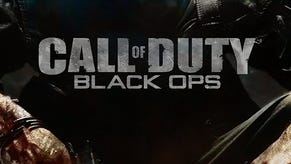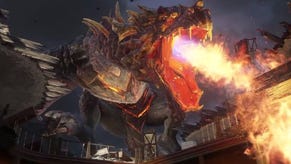Face-Off: Call of Duty: Black Ops 3
PC, PS4 and Xbox One versions under the microscope.
Black Ops 3 is perhaps the biggest Call of Duty game yet. Single-player and co-operative campaign modes - online and split-screen - are joined by classic PvP multiplayer and the return of the popular Zombies mode. Based on the lavish effects work present in the new game, Treyarch is clearly keen to push the graphical spectacle on consoles further than ever before and this has clear repercussions on the core experience. Our initial impressions of the campaign showed highly variable levels of performance, while the use of dynamic resolution scaling meant that image quality doesn't always impress - particularly on Xbox One, where sub-900p imagery is commonplace.
Returning to Black Ops 3 for this full Face-Off, a number of matters remained outstanding - could Treyarch match or indeed improve upon the accomplished performance in the multiplayer modes we tested in the beta phase? And on top of that, given the performance issues we encountered in the console campaign, could we power past those limitations with the PC version? Advanced Warfare was highly optimised for PC, and we were very curious to see if Black Ops 3 could follow suit.
Of course, one area where PC gains a guaranteed advantage over console is in terms of resolution. There's no dynamic framebuffer set-up here (not even as a selectable option) and running at a fixed native resolution allows us to achieve a consistent level of image quality throughout. In terms of anti-aliasing, more options are available to PC owners, with standard SMAA T2x offering up a visibly sharper image than the filmic SMAA implementation used on consoles, at the expense of letting through more jaggies, particularly on long edges. If you'd prefer the console look, that's still an option though - the filmic variation is also available. This works well on consoles in providing a clean presentation across near-field and distant details, though some high frequency texture information is smoothed over in the process.
While it may lack the dynamic resolution scaler, Blacks Ops 3's display settings menu does allow players to run native rendering resolution independently of the output resolution. In practise, for those gaming at a native 1080p, this means that you can maintain HUD elements at native resolution while gameplay itself renders at anything from 960x536 to 3840x2160. It's a far better solution than a one-size-fits-all resolution selection. Upscaling reduces GPU load significantly and keeps HUD elements looking as they should, while downsampling offers excellent anti-aliasing.
Ultimately, image quality on console has a very close relationship with rendering resolution, and it's here PS4 gains a considerable advantage: Treyarch uses a dynamic framebuffer in both platforms, but the implementation is less aggressive on PS4 with permanently higher pixel counts compared to the Xbox One game. When the engine is under load, native resolution drops down to 1360x1080, but much of the time we're graced with a native 1080p image. By comparison, outside of cut-scenes, the Xbox One game usually hands in a native 1280x900 presentation, with horizontal resolution dropping down to 1200 pixels fairly often. Not all cut-scenes are locked at 1080 vertical resolution either, and a few of these sequences get the dynamic 900p treatment too.
Outside of resolution, Black Ops 3 targets the same level of graphical quality across both consoles, with art and effects work deployed to a mostly equal standard. Occasionally, the use of a dynamic 900p framebuffer appears to cause the engine to select lower quality textures and normal maps on Xbox One on close up surfaces and objects, but this happens infrequently, and has little impact throughout the game.
In comparison to the PC version, texture detail appears to run using a combination of extra and high settings on consoles, while mesh detail is similar in places to both medium and high. Most of the core artwork is a close match to the PC version using the extra preset, but ground details often feature lower resolution textures on consoles, while character texture quality usually looks the same. Geometry details on characters are a match for the maxed PC game too, though many environment objects are rendered with slightly less complexity - such as random debris and broken furniture scattered across the ground.
Elsewhere, anisotropic filtering operates using the medium preset on consoles, leading to blurrier textures at oblique angles, while shadow quality seems to fall somewhere between medium and high. These elements feature similarly dithered edges to PC's medium setting, but with less break up and flicker. Visual effects like motion blur, depth of field and subsurface scattering skin rendering appear identical across all three platforms. Ambient occlusion is a close match for the high preset, while volumetric lighting is a good match for medium settings on PC.
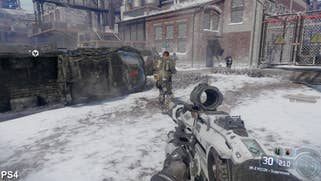




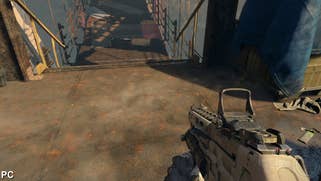





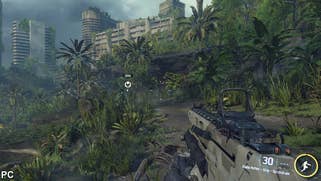



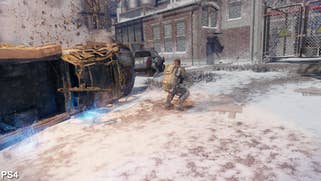
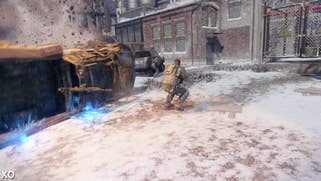

All in all, shadows look cleaner on PC, the lighting model appears more refined, and we also see better consistency across the quality of artwork deployed across the game, with smooth geometric surfaces and intricate texture detailing. It's not a revelatory upgrade over consoles, but it allows the game to scale beyond 1080p without the artwork getting compromised. The gap between baseline console and PC assets and effects is quite subtle, and Treyarch appears keen on trying to deliver a high-end experience on the PS4 and Xbox One, with many aspects of Black Ops 3's graphical make closely falling into line across all platforms. Of course, moving up to the extra preset and taking advantage of down=sampling at higher resolutions adds a welcome boost in refinement to the PC version, although this does come with a significant impact on performance.
For example, take our i5 3570K and GTX 780 powered gaming rig used for this feature. With all settings completely maxed out while running native 1080p resolution with SMAA T2x it's impossible to achieve anything close to 60fps outside of a few brief moments - performance stays within 30-45fps for extended periods and often delivers a subjectively inferior gameplay experience to the consoles. Lowering shadows down a notch, dropping anisotropic filtering and volumetric lighting to medium, and ambient occlusion to high provides a massive step up in frame-rates. A near solid 60fps is possible during gameplay, although cut-scenes still struggle to hit this target. Dropping texture and mesh quality down to high help to improve things further, but doing so reduces detail levels below console standards in a few areas. We also tested the game on an i7 system with a GTX 980 Ti - here we stay much closer to our target 1080p60, but there's still frequent judder, especially in cut-scenes.
Multiplayer on the i5 system is a different story: max settings at a locked 60fps is possible throughout gameplay, though killcam sniper scope viewpoints saw us drop to 53fps and the intensive air-strike effects that impact console performance are similarly disruptive here. Clearly, just like the console versions, Black Ops 3 places fewer demands on the system in standard multiplayer mode.



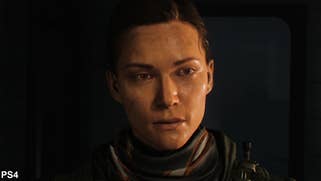








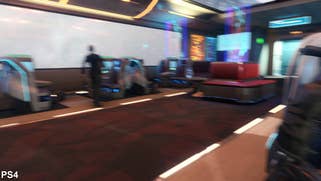


In terms of performance, our initial look at the campaign mode showed a disappointing turnout for both PS4 and Xbox One, with neither version coming close to hitting a sustained 60fps. However, for many Call of Duty players, the campaign is something of a short diversion with the meat of the game found in the series' ultra popular multiplayer modes. The Black Ops 3 multiplayer beta presented us with a more consistent gameplay experience than the shaky campaign, and that still holds true in the final release, though there are some changes to be found.
Cutting back on lighting, the amount of effects work and large set-pieces allow Treyarch to reign in performance so that we get far more closer to a stable 60fps throughout the vast majority of multiplayer matches. Occasional dips between 50-60fps create brief moments of stutter, but these last for a few seconds at most before the silky smooth 60fps lock is resumed. Much like the campaign, adaptive v-sync is employed here and the engine allows for tearing at the top of the screen to help reduce the size and duration of frame-rate drops and to improve latency.
In more demanding scenes, the engine is more intensely put through its paces. Airstrikes in particular see performance impacted more substantially across both platforms; on PS4 a barrage of explosions causes frame-rates to drop down near the 30fps mark - though only for a few seconds - while Xbox One metrics hover in the mid-40s. However, it's impossible to produce like-for-like gameplay in multi-player, and judging by the results it's likely that Xbox One could dip further under closer matches conditions. Certainly, the higher instances of torn frames suggest that overall load is more difficult to manage on the Microsoft platform. Thankfully, these moments are relatively infrequent, and don't usually impact Call of Duty's twitch-based shooting. Overall, it's a class above the uneven campaign.
In terms of image quality, dynamic resolution is now used in multiplayer, to varying effects. PS4 runs at something approaching a locked, native 1080p with just a few almost unnoticeable resolution drops. However, Xbox One delivers a native 1600x900 image, dropping down to anything as low as 1200x900. Curiously, these shifts in framebuffer resolution often occur when there isn't much action on-screen and are more pronounced on some maps than others. This produces a generally fuzzier presentation, where distant enemies are more difficult to spot, although the game spends less time at lower resolutions compared to the campaign, and frequently creeps back up to its top-end 1600x900 rendering resolution.
The campaign mode is a far less stable affair than multiplayer, and Black Ops 3 falls short compared with last year's Advanced Warfare on both consoles. Frame-rates tend to regularly fluctuate between 40-55fps in most combat scenes, with only occasional moments where the engine delivers a solid 60fps without any dips or torn frames. This means that much of the intense action throughout the campaign is beset by judder and fluctuating controller response that doesn't deliver the crisp and consistent feel usually found in Call of Duty games.
It's disappointing to see such uneven frame-rates as some of the most exciting moments come in the form of large battles spread across open areas, with several explosive set-pieces featuring buildings crumbling around the battlefield, while aircraft explode in mid-air in spectacular style. Conceptually, these sections are up there with the best of Call of Duty's explosive campaign moments, but sadly performance lets this area of the game down. In comparison, enclosed spaces and smaller locations offer smoother firefights that feel snappy and look consistently fluid - occasional dropped or torn frames go by unnoticed and the result is a 'perceptual' 60fps with excellent low latency gameplay that one would expect to see from this series. It's just a shame that Treyarch wasn't able to maintain this level of performance throughout a larger part of the game.
Call of Duty: Black Ops 3 - the Digital Foundry verdict
Treyarch is keen to push back technical boundaries for this franchise, and as a result we see PS4 and Xbox One versions matching the PC game with many of the highest settings enabled across much of the presentation. This delivers a lavish visual spectacle that certainly impresses during the series' extravagant set-pieces, but it also means that the engine often struggles to deliver anything approaching a solid frame-rate. There's not much in it in terms of performance between consoles, but the PS4 manages to carve out an advantage during the campaign with its consistently higher resolution - often native 1080p - while things are less rosy on the Xbox One, where the more aggressive dynamic framebuffer implementation can have a serious impact on image quality.
Multiplayer is the saving grace for the game on both platforms. While resolution drops below the intended 900p on Xbox One, both consoles regularly achieve a slick 60fps experience with noticeable drops limited to explosive scenes. The PS4 version comes out ahead on the basis of providing a higher resolution, but the series' fast-paced twitch shooting still works well on Xbox One. In that respect the Sony platform has an overall advantage, but if you primarily play online, the Xbox One version is still a solid choice if that's the platform where your friends are. Activision's marketing priorities have changed - and PS4 also has the advantage of getting DLC content ahead of other platforms.
The PC version powers past the console releases in terms of the raw feature-set, but the graphical upgrade while running in 1080p is actually smaller than expected, with PS4 in particular coming very close in several areas. Optimisation also appears a little lacking here, and hitting solid 60fps while completely eclipsing console level visuals in areas aside from raw resolution isn't easy without utilising some high-end kit. And even there, the frequent stutter often distracts. Those using lower-end hardware are likely to struggle - and that's a real disappointment, bearing in mind how accomplished Advanced Warfare operated even on budget-orientated PC hardware. In theory, it's the PC version that should be the preferred platform for Black Ops 3, but it doesn't quite feel like quite the finished article - right now, it feels like PS4 offers the best experience without having to spend a fortune on hardware.




